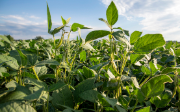
Breeding soybean varieties adapted to both climatic and commercial conditions of Switzerland.
Selection criteria
- A quality adapted to human nutrition with good processing properties and improved taste
- Very high protein content and quality
- Good cold tolerance during the flowering period
- Low requirements in terms of accumulated temperature
- A sizeable, regular yield and high resistance to different diseases of soy (mildew, stem rot, Psuedomonas, etc.)
Publications choisies
Partner:

Soybean’s high nutrient content is a big draw. Here in Switzerland, this legume is consumed primarily in the form of soy drink, tofu or soy sauce.

The aim of soybean breeding is to adapt the plant, which originated in China, to Swiss conditions. Agroscope varieties are early ripening, cold-tolerant during flowering and disease-resistant, in addition to yielding stable harvests and meeting European taste preferences.

Tofu is high in protein and polyunsaturated fatty acids, in particular Omega-3 fatty acids. An important source of calcium and iron as well as cholesterol- and lactose-free, soya gets a big thumbs-up from nutritionists

For over 40 years now, Agroscope has been breeding non-GMO soybeans, focusing in particular on their food properties such as taste and suitability for processing. These important research findings have contributed significantly to the success of soybean cultivation in Europe.

In Switzerland we eat twice as much meat as is recommended from a nutritional perspective (see food pyramid). Soy protein is practically equivalent to animal protein but requires much less energy for its production. A needs-based diet could reduce the negative effects on the environment by half. Environmentally Conscious Eating (admin.ch)

Soybean varieties with suitable agronomic and technological properties are crossed. Over the course of the generations, numerous field, greenhouse and laboratory trials lead to the breeding of innovative new varieties suited to Swiss climatic conditions. After 12 to 15 years’ breeding work these varieties are multiplied and offered to farmers for cultivation.

Agroscope researchers test the progeny obtained from conventional crossings. These plot trials are repeated several times at various locations in Switzerland.

The soybeans used to make tofu must be of impeccable quality. Colourless types of beans with a yellow hilum are in demand, as they yield a light-coloured tofu with no unfavourable coloration. However, tofu can also be made from beans with a coloured hilum.

Soybean has very little need of mineral nitrogen fertilisers. Being a legume, it can bind atmospheric nitrogen to its roots by means of rhizobia (nodule bacteria), thus making nitrogen available to the plant. The nitrogen ensures a high protein content and stable yields.







